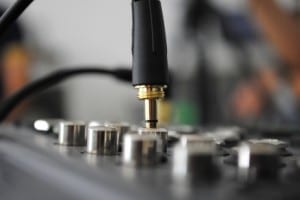Passive Versus Active Direct Boxes
They’re most commonly called a DI box, which technically stands for Direct Input or Direct Injection box, depending on who you ask. Sometimes it’s simply called a Direct Box. As you can see, these can get a bit confusing just parsing out the name, and that’s before you even get into the two kinds of DI boxes: passive and active.

Here we’ll take a simple look at not only the differences between each, but also when to use each. Whatever you call the box, it is one of the most important tools to have in your studio and on a concert stage.
Purpose of the DI Box
Before taking a look at the difference between passive and active boxes, it is important to understand exactly what a DI box is used for in the first place. Essentially, the box is just a converter -- but it is a very important converter.
The input of the boxes take a 1/4” instrument cable, often from a guitar, bass, keyboard or any other instrument using this type of plug. The output of the box, however, is an XLR jack, which can be connected to a recording console or to a live mixer.
But the conversion process is more important than just the types of outputs and inputs, as it also converts an unbalanced signal to a balanced signal. A 1/4” instrument cord carries a strong, unbalanced signal, and though these can often be connected directly to a mixer or recording console, converting that signal to a balanced signal that eliminates interference and hum as well as the compatibility issues inherent when using different connector types.
Passive Direct Box
The most basic definitions of the two different kinds of DI boxes are likely what you’d expect: passive does not have active electronics and therefore does not require an external power source. In contrast, active boxes do have active electronics, which are powered by external power sources.
In more technical terms, a passive direct box acts essentially as a transformer. In doing this, it isolates the audio signal and eliminates the 60-cycle hum from ground loops. An active box does not eliminate this.
Active Direct Box
But there is also a distinct advantage of active direct boxes, namely that they provide gain to a weak signal, essentially acting as a type of preamp. The more complex methods of converting the unbalanced to the balanced requires an electronic circuit that must be powered by outside sources -- most boxes take batteries, AC power and/or phantom power.
Other Direct Box Features
Some direct boxes are extremely simple, and don’t including anything but one input and one output. Others, however, include additional features. Two of the most common are switches for ground lift and pad lift.
- Ground Lift
Ground lift can be used to eliminate hum or hiss caused by ground loops. These loops occur when multiple grounds are created in an audio chain.
- Pad Lift
A pad lift reduces the sensitivity of a box. Therefore, if an extremely strong signal is sent to the box from an instrument, the pad lift will prevent the box from overloading.
While there are many more features that can be found on DI boxes, these are among the most common. Again, depending on what you are recording, these can be essentially to getting the best sound possible out of your home studio.




